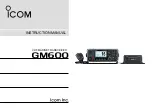
When placing the PCB into the enclosure, the rear has to line up first and
then, with a twisting motion, the rear connectors will move into the proper
holes. While doing this, hold the ribbon cables so that they do not get
stuck under the board. Now replace all the screws and the metal clip
holding down the PLL shield. Plug in the red and green coaxial cables and
the three white ribbon cables (do not twist them; align them properly
before pushing them gently into place).
Recheck all the connections and the placement of all the screws. Now
place the lid onto the transceiver, plug in the speaker cable and push the
lid into place. Replace all the screws into the lid.
Connection of the LIF converter (RX-only)
The LIF RX output of the transceiver connects to the IN port (TB1) of the
LIF assembly and the audio Line out (TB3) connects to the tip line-in of
the sound card. TB2 provides power (+12V). TB5 is not used for the RX-
only version. A jumper has to be placed on TB4 between 3-4 to by pass
the 7kHz high pass filter or between 4-5 to enable it.
Note:
The transmit audio is still filtered with the existing filter inside the IC-
703. If the MDSR is properly configured the standard microphone can be
used to transmit, while the RX is processed through the computer.
For more details see “Lock to TXCR” the MDSR help menu.
Setup of the CAT interface
The MDSR software controls the transceiver via the CAT port. The
connector cable CI-V is the Icom version of the interface cable that plugs
into the back of the radio and the RS-232 port of the computer. There are
also virtual RS-232 cables available that connect via the USB bus to the
computer.
Summary of Contents for IC-703
Page 5: ......






















